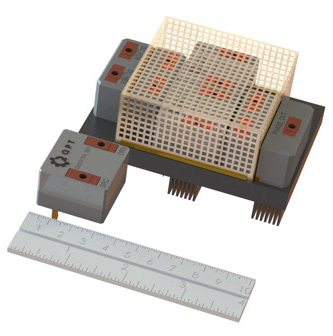News: Microelectronics
13 July 2023
QPT and GaN Systems sign MoU to develop technologies to extend EV driving range
Power electronics company Quantum Power Transformation (QPT) of Cambridge, UK (which was founded in 2020) announced in late May that it had created the drive, control and sense technologies to maximize gallium nitride (GaN) transistor performance and overcome design challenges in the 100kHz to 20MHz frequency range for high-power and high-voltage applications that use hard switching. This technology is now unleashing the power performance in GaN-based designs, most dominantly in the automotive industry.
QPT says that its solution requires high-speed GaN transistors to deliver GaN’s promised power efficiencies. The firm has signed a memorandum of understanding (MoU) with GaN Systems Inc of Ottawa, Ontario, Canada (a fabless developer of GaN-based power switching semiconductors for power conversion and control applications) to investigate the possibilities of developing these technologies, resulting in increased performance and further improvements that can boost the driving range of electric vehicles (EVs).
“GaN Systems produces the highest performing 650V power GaN devices, and this allows us to achieve the highest efficiency when combined with our technology,” says QPT’s founder & CEO Rob Gwynne. “The better the efficiency of power usage, the greater the range of the EV.”
QPT has “unlocked functional improvement in performance, resulting in a highly optimized GaN solution for the EV market,” comments GaN Systems’ CEO Jim Witham. “In partnership, GaN Systems’ transistors and QPT technology could dramatically change the GaN market.”
The most significant boost to the EV range comes from QPT’s ability to drive GaN much more efficiently. GaN transistors can operate at higher frequencies for switching on and off. The higher the switching speed, the less time is spent in transition, and the less energy is lost. GaN transistors can quickly transition from on to off at 1–2ns instead of 20–50ns for silicon and silicon carbide (SiC) transistors. However, achieving maximum performance is challenging in some high-voltage, high-power applications.
QPT’s solution enables the GaN transistors to be run at their full potential of up to 20MHz with nanosecond switching to deliver better operational precision without RF interference issues or overheating, it is claimed. The firm’s technology enables motors to be driven at up to 99.7% efficiency at peak load with hardly any decrease in efficiency at lower loads. This is currently a challenge for conventional designs, where the efficiency can drop off rapidly at lower loads.
An additional boost comes from integrating and shrinking the variable-frequency drive (VFD) that controls the motor speed. Existing VFDs are bulky, so they are invariably located away from the motor itself and then connected by copper cables that are big and heavy to cope with the hundreds of Amps going through them. QPT says that its GaN technology shrinks the size of a VFD to about a 20th of the size, reducing weight. More importantly, the size reduction means that it can be co-located beside the motor.
 Picture: QPT's qGaN modules forming a VFD solution.
Picture: QPT's qGaN modules forming a VFD solution.
This integrated motor solution is said to eliminate the need for long, heavy copper cables, which can amount to a significant weight and cost reduction of about half a meter each. Additionally, the copper cables have resistance marking less power loss and reducing the overall system efficiency. All these factors mean that QPT’s solution without copper cables can increase the range of the car, it is reckoned.
“Our calculations show that our VFD solution can reduce power usage by around 10% and even more when the motor operates at low speeds,” says Gwynne. “Together with the benefits of no long cables, that can significantly increase the range of an EV or a smaller battery for the same range,” he adds. “Our technology is encapsulated into modules to form a plug-and-play solution that can be dropped in to replace an existing VFD with the rest of the existing system, such as the microprocessor and software stack, staying the same.”
QPT’s modules enable GaN to operate at up to 20MHz without overheating or RF issues








